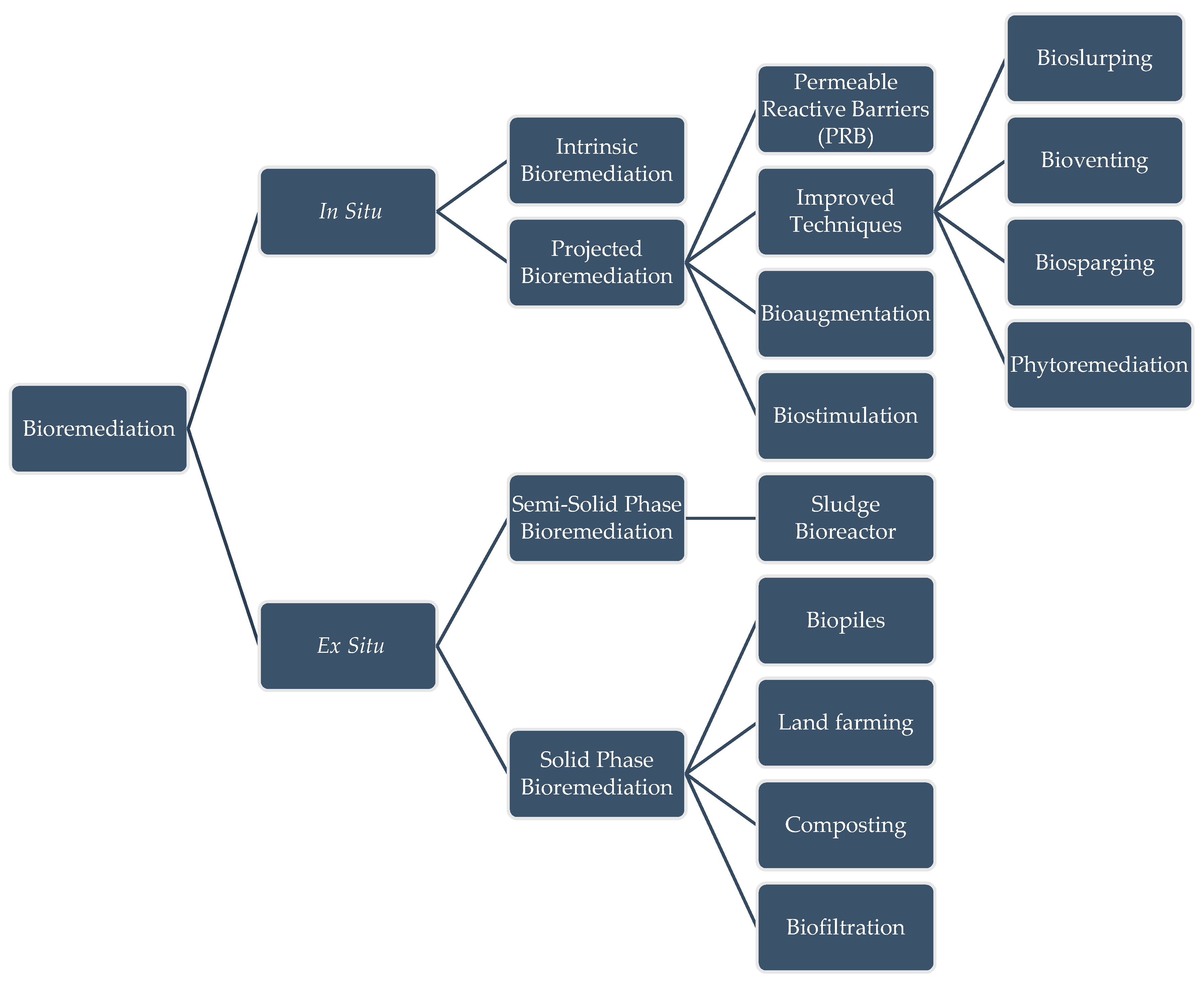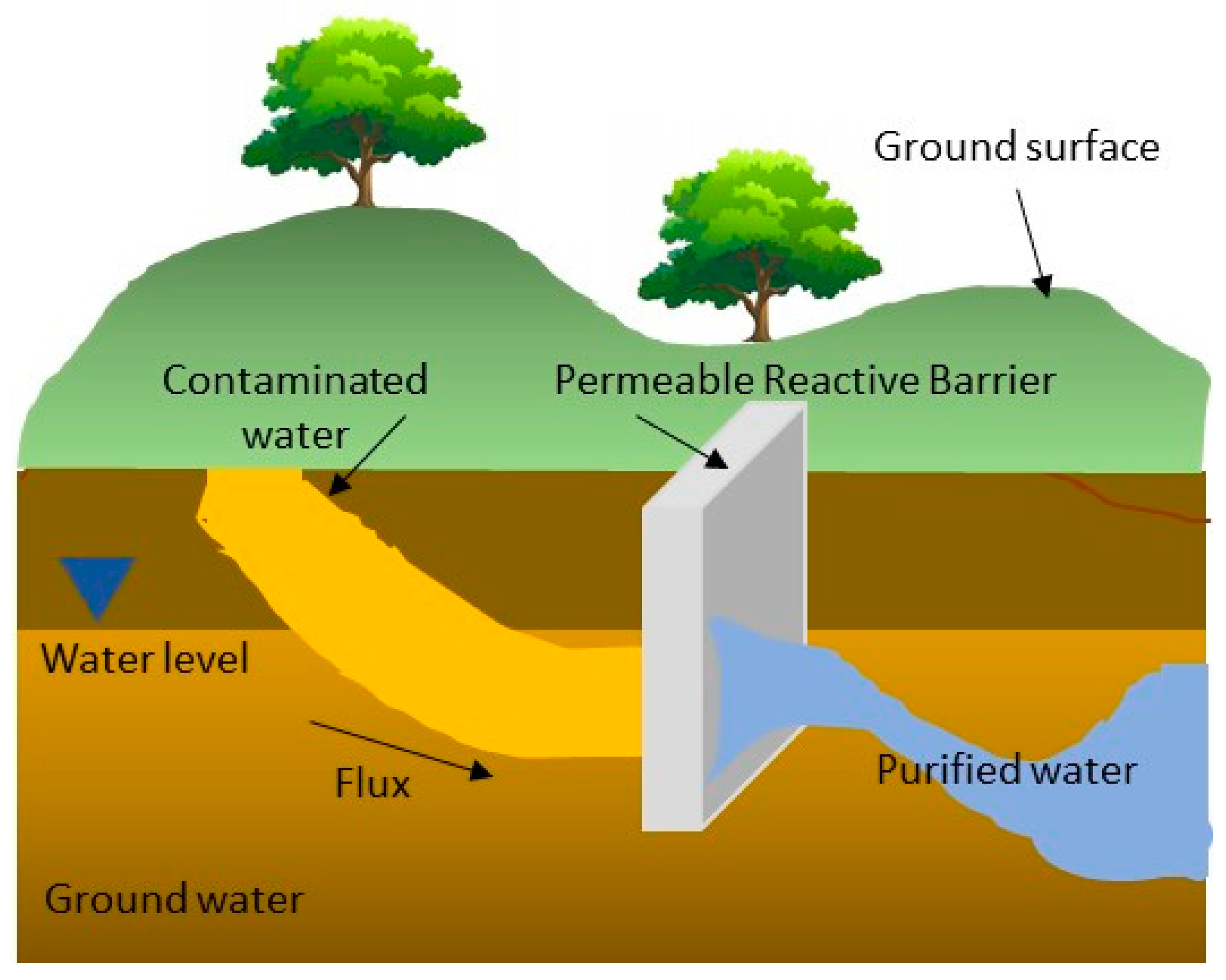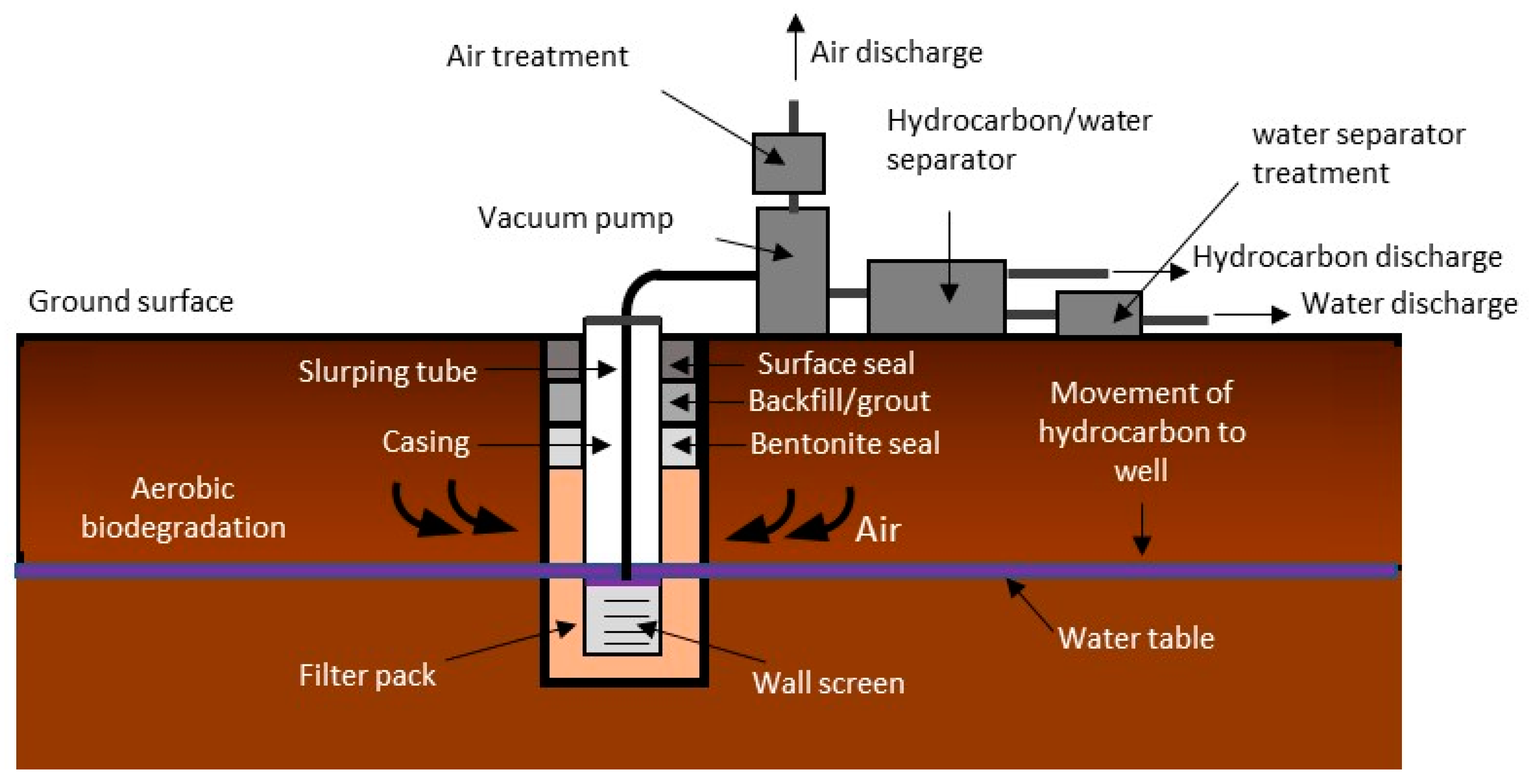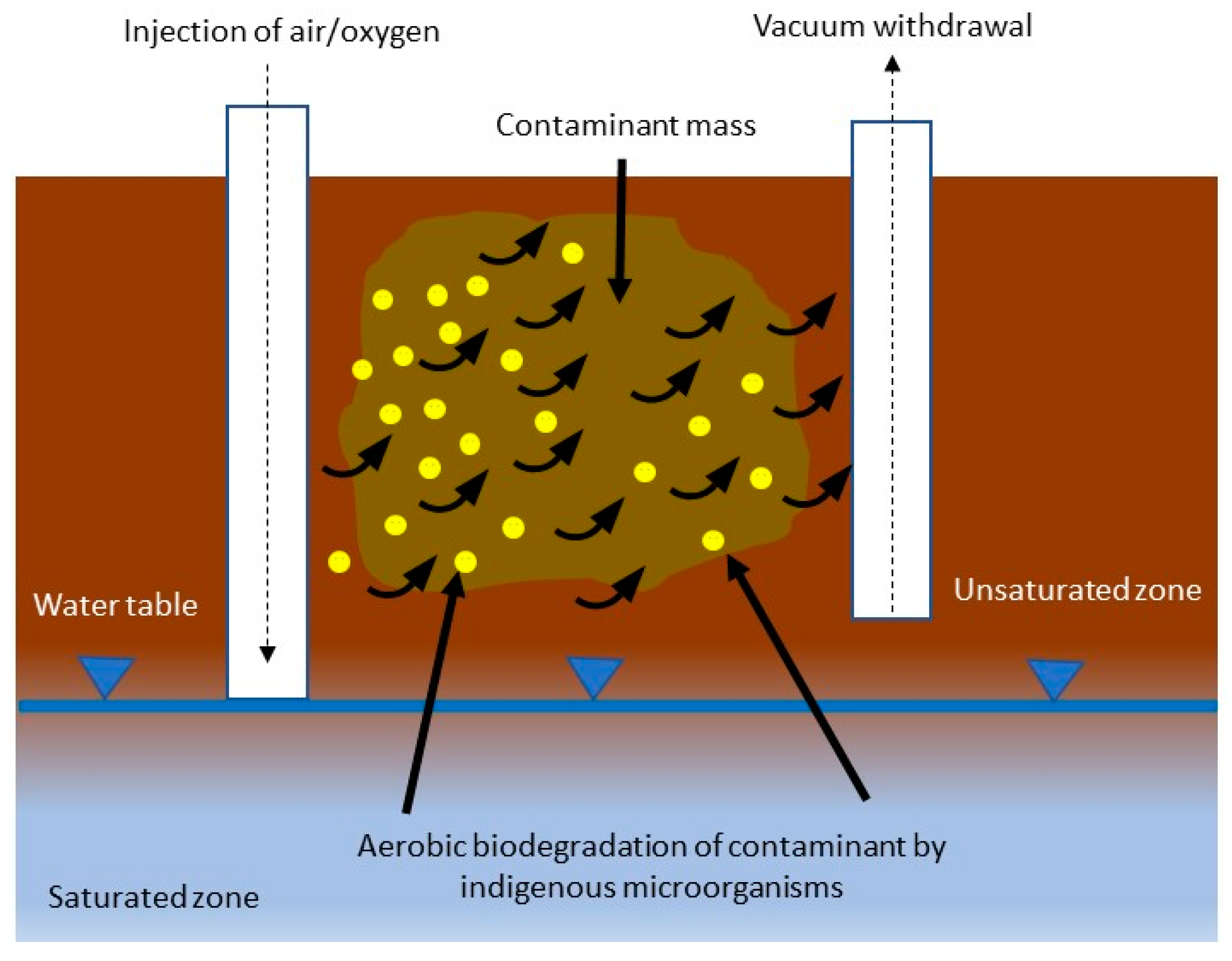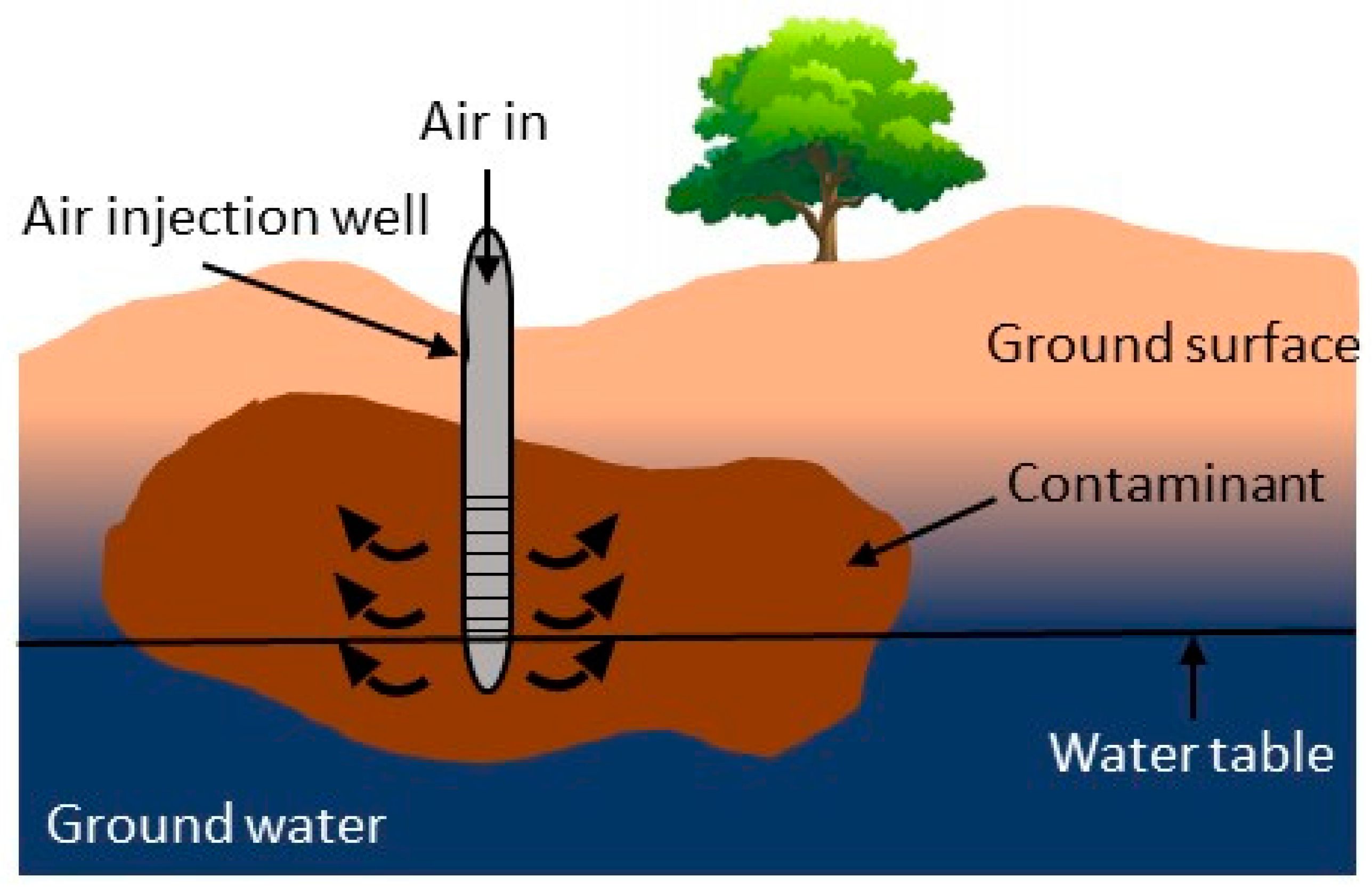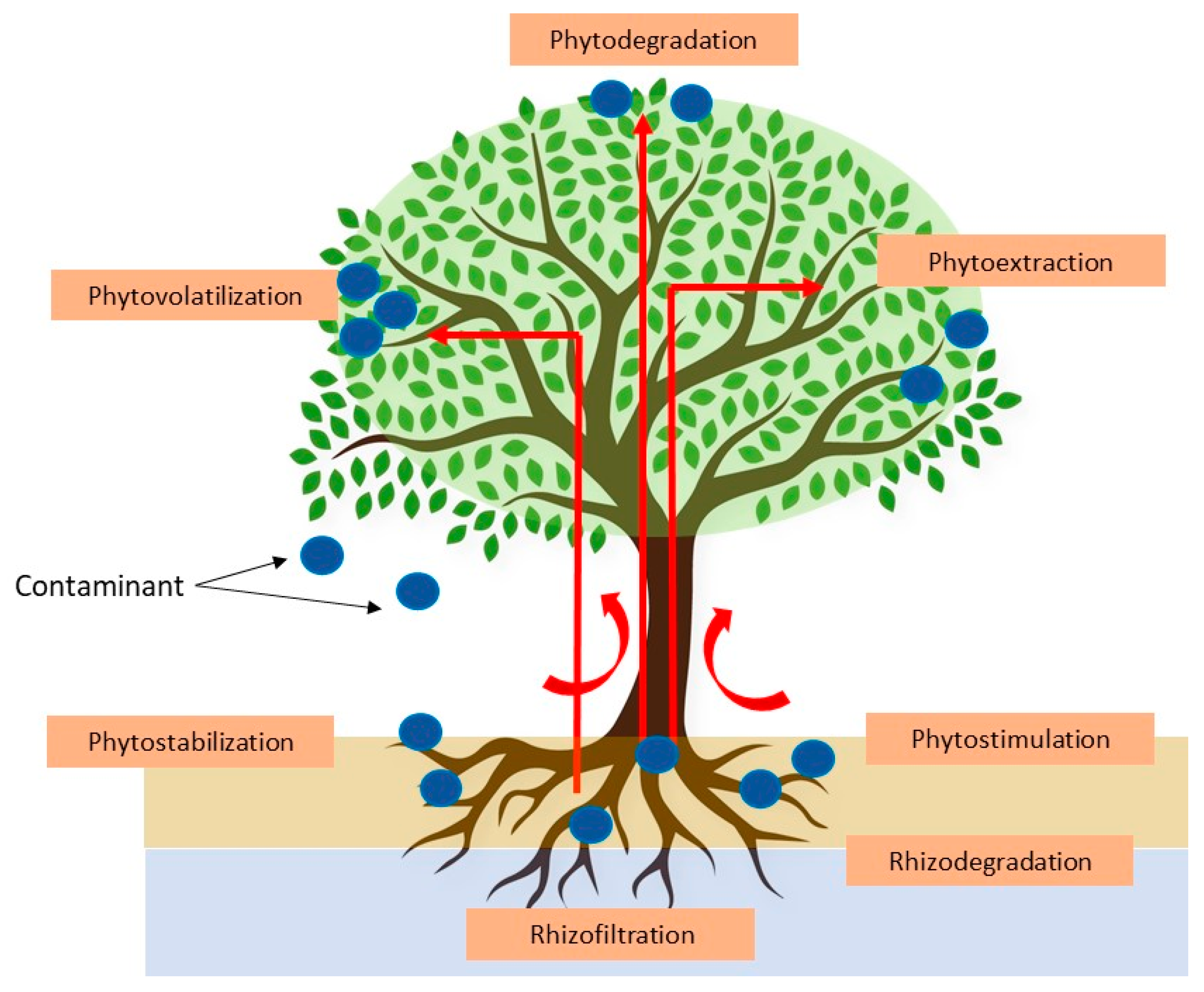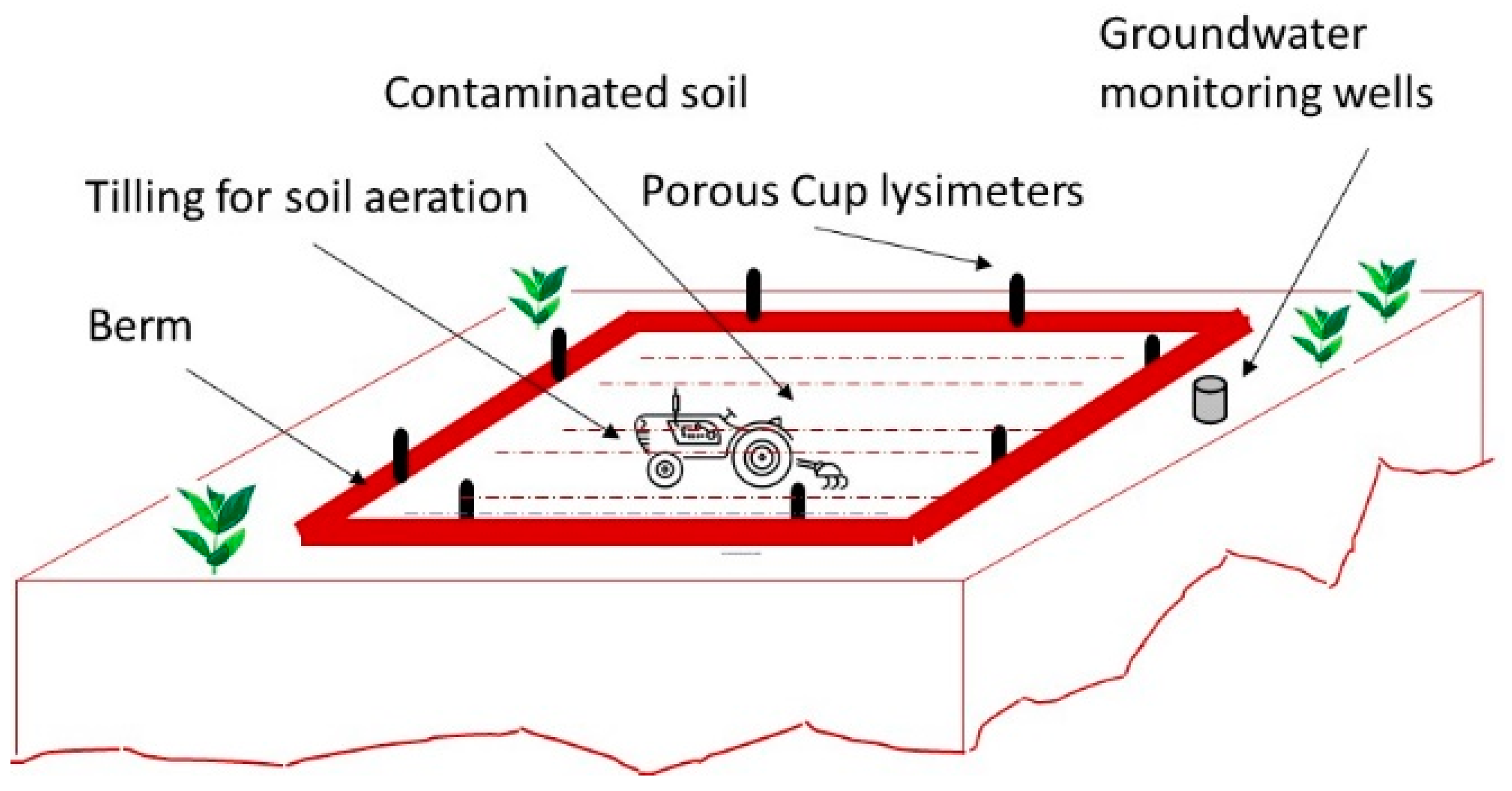Petroleum hydrocarbons, heavy metals and agricultural pesticides have mutagenic, carcinogenic, immunotoxic and teratogenic effects and cause drastic changes in soil physicochemical and microbiological characteristics, thereby representing a serious danger to health and environment. Therefore, soil pollution urgently requires the application of a series of physicochemical and biological techniques and treatments to minimize the extent of damage. Among them, bioremediation has been shown to be an alternative that can offer an economically viable way to restore polluted areas. Due to the difficulty in choosing the best bioremediation technique for each type of pollutant and the paucity of literature on soil bioremediation enhanced by the use of specific additives, we reviewed the main in situ and ex situ methods, their current properties and applications. The first section discusses the characteristics of each class of pollutants in detail, while the second section presents current bioremediation technologies and their main uses, followed by a comparative analysis showing their respective advantages and disadvantages. Finally, we address the application of surfactants and biosurfactants as well as the main trends in the bioremediation of contaminated soils.
- bioremediation
- surfactant
- biosurfactant
- environmental biotechnology
- soil
1. Introduction
Bioremediation is the process by which living beings such as plants, algae and microorganisms are used to remediate, reduce or remove contamination from the environment
[1]
. Hydrocarbons are broken down by microorganisms and plants into greener products, or are converted by other microbial species into water, CO
2
and other inorganic compounds
[2]
. Since effective bioremediation requires the action of microbial enzymes to transform contaminants into non-hazardous compounds, operating conditions must be optimized to allow microbial cells to quickly biodegrade them
[3]
. This bioprocess has appeared among the most promising emerging treatments to remove oil and derivatives since its first use in 1989 to remediate the environmental disaster of Exxon Valdez
[4]
.
Hydrocarbon bioremediation, which involves heterogeneous and complex processes, is highly efficient, but still takes a few weeks or even months to complete. The use of microorganisms is influenced by some factors including the type of pollutant, the environmental conditions, as well as the presence of nitrogen and phosphorus sources
[5]
. Temperature has a strong impact on oil hydrocarbon degradation, due to its influence on petroleum physical state and chemical composition, microbial metabolism, and composition of microbial consortium
[6]
. Optimal temperature of hydrocarbon biodegradation is influenced by climate, site location and microbial species
[7]
. Even though hydrocarbon degradation occurs over a wide temperature range, usually the higher the temperature, the faster the bioprocess
[8]
. Other important factors that directly influence bioremediation are the medium pH, redox potential, moisture content, availability of oxygen and other compounds, soil/water composition and pollutant solubility
[9]
. It is important to note that this technology has its own limitations. Chlorinated hydrocarbons, for example, or other aromatics are almost recalcitrant to biodegradation or are biodegraded very slowly
[10]
.
A case study conducted on pentachlorophenol in New Mexico identified the following main factors influencing the outcome of bioremediation of organic compound-polluted soil: (1) pesticide bioavailability, (2) rate of microbial uptake, (3) rate of enzymatic degradation, and (4) rate of cell growth using the pesticide as carbon and energy source
[11]
. The main soil conditions, including pH, and the microbial consortium formed by Arthrobacter sp. and Flavobacterium sp., were critical in determining the success of bioremediation.
2. Classification
Figure 1.
Different bioremediation strategies.
2.2. In-Situ Techniques
In the context of bioremediation, the term “in situ” means that bioremediation takes place at the contaminated site, without the transfer of polluted materials
[10]
In-situ techniques can be classified as intrinsic or projected bioremediation
[12]
, the latter being composed of a series of techniques.
2.2.1. Intrinsic Bioremediation
Alternatively called passive bioremediation or natural attenuation, intrinsic bioremediation is a natural degradation process that depends only on the metabolism of native microorganisms to destroy dangerous contaminants, using no artificial stage to enhance biodegradation activity
[13]
. The absence of external factors makes this process the cheapest in-situ bioremediation technique. However, continuous monitoring is needed for bioremediation to be continuous and sustainable.
The main requirements to be met to make the application of intrinsic bioremediation effective are the following
[13]
.:
- suited population of biodegrading microorganisms in the polluted site;
- optimum environmental conditions (temperature, pH, moisture degree, O
- 2 concentration);
- available carbon and nitrogen sources to sustain microbial activity and growth;
- sufficient time for microorganisms to convert pollutants into less harmful products.
Considering that native microorganisms are highly effective in degrading pollutants because they are already adapted to the site conditions, and that there is a microbe/hydrocarbon relationship established in the course of evolution, the hydrocarbon-degrading ability is common among microbial consortia [
]. Before applying intrinsic bioremediation, however, a risk assessment should be performed to ensure that the time required to complete bioremediation is shorter than that required by the contaminant to reach the closest point of human and animal exposure.
2.2.2. Projected Bioremediation
Permeable Reactive Barriers (PRBs) are an in-situ technology applied to remediate groundwater contaminated by many types of pollutants such as chlorinated hydrocarbons and heavy metals
[14]
(
). A permanent or semipermanent reactive barrier composed mainly of iron is immersed in the contaminated groundwater stream
[15]
. When contaminated water naturally flows through the barrier, the contaminants are trapped and react, releasing purified water
[16]
. Ideally, PRBs are sufficiently reactive to capture pollutants, permeable to allow water to flow, passive with little energy consumption and cost-effective
[17]
. The efficiency of such a technology relies on the type of medium, which in turn depends on the type of pollutant, environment, health effects, biogeochemistry, hydrogeology, system steadiness and cost
[18]
. In the past few years, PRBs have been coupled with other techniques to treat different classes of contaminants
[19]
.
Figure 2.
Scheme of Permeable Reactive Barriers (adapted from
[14]
).
Bioslurping
Also known as multiphase extraction, bioslurping combines enhanced vacuum pumping, soil vapor extraction and bioventing to perform remediation of groundwater and soil by indirect O
2
supply and improve pollutant degradation
[20]
. (
).
Figure 3.
Scheme of operation of bioslurping (adapted from
[21]
).
The main disadvantage is the excessive moisture of soil that reduces air permeability, O
2
transfer rate and microbial activity. Furthermore, bioslurping is unsuitable to treat low permeable soils
[22]
.
Bioventing
Bioventing involves controlled stimulation of the air flow, providing oxygen to increase microbial activity and, consequently, enhance bioremediation
[23]
(
). Usually, nutrients and humidity are added to achieve transformation into pollutants that are more harmless to the environment and to improve remediation. This technique has been used successfully in the remediation of soils polluted by oil products
[24]
.
Figure 4.
Typical bioventing system (adapted from
[25]
).
Biosparging
In biosparging, air is introduced into the soil to promote the degradation capacity of microorganisms. In contrast to bioventing, air is introduced inside the saturated area, causing the upward movement of volatile pollutants (
).
Figure 5.
Typical biosparging system (adapted from
[21]
).
Phytoremediation
Phytoremediation refers to the use of plants in polluted sites to promote biological, biochemical, physical, microbiological and chemical interactions to attenuate the toxicity of contaminants
[22]
. Depending on the type of pollutant, it occurs through different mechanisms, namely biodegradation, vaporization, filtration, among others. Elemental contaminants like heavy metals or radioactive elements are mainly extracted, transformed and sequestered, while organic contaminants are eliminated mainly through rhizodegradation, biodegradation, vaporization or stabilization
[26]
.
Within phytoremediation, there are many different ways that plants interact with contaminants
[27]
(
):
Figure 6.
Descriptive illustration of phytoremediation techniques (adapted from
[28]
).
2.3. Ex-Situ Techniques
In this case, the polluted material is removed and degraded in special facilities outside the incident site
[29]
. After excavation, the polluted soil is transported elsewhere for treatment. The selection of an ex-situ bioremediation technique is usually made on the basis of the following aspects: operating costs, extent and depth of contamination, type of contaminant, location and geological features of the contaminated site
[20]
.
2.3.1. Bioreactors
The term ‘bioreactor’ refers to any equipment or manufactured facility that supports a bioactive system. Sludge bioreactors are used to treat hydrocarbon pollutants safely and easily. Contaminants are kept in a containment container where, using various types of devices to mix the sludge, a mixture is obtained consisting in a three-phase solid, liquid, and gaseous system. The biofilm formed stimulates the biodegradation of pollutants and increases the biomass level
[30]
.
2.3.2. Biopiles
Bioremediation through biopiles consists in the piling of contaminated soil and subsequent aeration to promote biodegradation mainly by improving microbial activity. The elements of this technology are watering, aeration, and leaching. Its use is increasingly taken into consideration thanks to its construction characteristics and the favorable cost-benefit ratio that allow efficient bioremediation, provided that adequate control of nutrients, temperature and aeration is ensured
[31]
.
2.3.3. Landfarming
Landfarming (
) is a soil bioremediation technique that involves mixing the contaminated soil with hydrocarbons to improve soil biological and physical factors as well as chemical processes for biodegradation
. It is among the most basic bioremediation technologies because of its low cost and low footprint. Landfarming can be classified as ex-situ or in-situ technology depending on where the treatment takes place.
Figure 7.
Typical landfarming system (adapted from
[32]
).
2.3.4. Composting
Composting is an ex-situ aerobic process by which organic waste is decomposed by thermophilic biological agents to obtain a humic amendment known as compost
[34]
, which is used as soil fertilizer
[35]
.
2.4. Surfactant-Enhanced Soil Bioremediation
Many methods are being developed to improve existing technologies, as well as to find new alternatives to treat polluted soil. Following this trend, the use of surfactants and biosurfactants may be an efficient option to assist soil treatment. Surfactants are amphiphilic compounds consisting of a hydrophilic portion (head) with high chemical affinity for water and a hydrophobic (tail) strongly repulsed by it, which are capable of reducing the surface tension of the liquids in which they are dissolved
.
2.4.1. Soil Washing Enhanced by Surfactants
Surfactant-enhanced soil washing and removal of lyophilic contaminants can occur in two different ways: the first, which consists of displacement, occurs below CMC, while the second, called solubilization, at higher concentrations.
2.4.2. Synthetic Surfactants
Synthetic surfactants include ionic and nonionic surfactants. Both have been used successfully to remove different types of toxic organic compounds as well as heavy metals contaminating the soil
[39]
.
2.4.3. Biosurfactants
Despite the application potential of synthetic surfactants, the environmental impact deriving from their difficult degradation has led to the development of their biological counterpart, namely the so-called biosurfactants
, which have a comparable efficiency and are among the most studied bioproducts nowadays
.
3. Conclusion and Future Perspectives
The bioremediation of contaminated soils is considered an environmentally friendly, versatile, and cheap technology, since in addition to restoring the damaged ecosystem at low cost, it reduces the risk to health and preserves biodiversity. Furthermore, well-designed bioremediation projects can create new markets and facilitate the management of contaminated soils, promoting the integration of sustainable socio-economic activities. The most used
in-situ
bioremediation techniques are bioaugmentation and biostimulation, while bioreactors are the most used
ex-situ
systems. Although
ex-situ
bioremediation processes allow many contaminants to be treated in a controlled way, they are generally costlier than the
in-situ
ones because of the additional excavation and transport expenses. On the other hand, even if the processes belonging to the latter category have the economic advantage of not including excavation, the cost of installing the equipment on site, associated with the impossibility of efficaciously seeing and controlling the contaminated site subsoil, can make some of them unviable. Consequently, the cost of remediation cannot be the only factor to consider in choosing the most suitable treatment to be applied to a given contaminated site. On the other hand, the lack of sufficient knowledge about the effect of various environmental factors on the rate and extent of biodegradation creates a source of uncertainty. It is important to point out that many field tests are not properly designed, controlled, or analyzed, generating uncertainty in the selection of response options. Therefore, the applicability of a soil bioremediation technique will be the result of the combination of a number of factors such as the location and type of contamination, objectives, expected efficiency, cost-effectiveness and duration of the remediation, and its public acceptability. The combined use of multiple techniques should also be considered, which makes it possible to increase the effectiveness of remediation and to minimize the individual disadvantages of each of them. Studies and planning, which help select the most suitable technique, must be conducted before it is implemented on a large scale. Moreover, a wide variety of microorganisms and metabolites with decontamination skills are still largely unexplored, and a better understanding of their natural role in the environment can improve their use. Finally, understanding the diversity of the microbial community in environments contaminated by oil and derivates is essential to gain a better view of potential oil degraders and to develop appropriate bioremediation strategies, thus preserving the long-term sustainability of terrestrial ecosystems.
References
- Saxena, G.; Bharagava, R.N. Bioremediation of Industrial Waste for Environmental Safety: Volume I: Industrial Waste and Its Management; Saxena, G., Bharagava, R.N., Eds.; Springer: Singapore, 2020; ISBN 978-981-13-1891-7.
- Banerjee, A.; Roy, A.; Dutta, S.; Mondal, S. Bioremediation of hydrocarbon—A review. Int. J. Adv. Res. 2016, 4, 1303–1313.
- Sergio Cisneros De La Cueva; César Hernández-Rodríguez; Nicolás Óscar Soto-Cruz; Juan Antonio Rojas Contreras; J. Lopez-Miranda; Changes in Bacterial Populations During Bioremediation of Soil Contaminated with Petroleum Hydrocarbons. Water, Air, & Soil Pollution 2016, 227, e91, 10.1007/s11270-016-2789-z.
- Mandy R. Lindeberg; Jacek Maselko; Ron A. Heintz; Corey J. Fugate; Larry Holland; Conditions of persistent oil on beaches in Prince William Sound 26 years after the Exxon Valdez spill. Deep Sea Research Part II: Topical Studies in Oceanography 2018, 147, 9-19, 10.1016/j.dsr2.2017.07.011.
- Qingren Wang; Shouan Zhang; Yuncong Li; Waldemar Klassen; Potential Approaches to Improving Biodegradation of Hydrocarbons for Bioremediation of Crude Oil Pollution. Journal of Environmental Protection 2011, 2, 47-55, 10.4236/jep.2011.21005.
- A. El-L. Hesham; S. A. Alrumman; A. D. S. Alqahtani; Degradation of Toluene Hydrocarbon by Isolated Yeast Strains: Molecular Genetic Approaches for Identification and Characterization. Russian Journal of Genetics 2018, 54, 933-943, 10.1134/s1022795418080070.
- Bagi, A. Effect of Low Temperature on Hydrocarbon Biodegradation in Marine Environments; Faculty of Science and Technology: Stavanger, Norway, 2013
- Sunita Varjani; Vivek N. Upasani; Upasani Vivek Narayan; A new look on factors affecting microbial degradation of petroleum hydrocarbon pollutants. International Biodeterioration & Biodegradation 2017, 120, 71-83, 10.1016/j.ibiod.2017.02.006.
- Zulfa Ali Al Disi; Samir Jaoua; Dhabia Al-Thani; Saeed Al-Meer; Nabil Zouari; Considering the Specific Impact of Harsh Conditions and Oil Weathering on Diversity, Adaptation, and Activity of Hydrocarbon-Degrading Bacteria in Strategies of Bioremediation of Harsh Oily-Polluted Soils. BioMed Research International 2017, 2017, 8649350-11, 10.1155/2017/8649350.
- Singh, P.; Pratap, R.; Vaibhav, S. Contemporary Environmental Issues and Challenges in Era of Climate Change; Springer: Berlin/Heidelberg, Germany, 2020; ISBN 9789813295940
- Ray, S. Bioremediation of pesticides: A case study. In Microbial Biodegradation and Bioremediation; Elsevier Inc.: Amsterdam, The Netherlands, 2014; pp. 514–520; ISBN 9780128004821
- Hazen, T.C. . Handbook of Hydrocarbon and Lipid Microbiology; Springer: Berlin/Heidelberg, Germany, 2010; pp. 2583-2596.
- Jot Sharma; Advantages and Limitations of In Situ Methods of Bioremediation. Recent Advances in Biology and Medicine 2019, 5, 10941, 10.18639/rabm.2019.955923.
- Deeper Look at Permeable Reactive Barriers. . www.cascade-env.com. Retrieved 2020-9-23
- Dan Zhou; Yan Li; Yinbo Zhang; Chang Zhang; Xiongfei Li; Zhiliang Chen; Junyi Huang; Xia Li; Giancarlo Flores; Masashi Kamon; et al. Column test-based optimization of the permeable reactive barrier (PRB) technique for remediating groundwater contaminated by landfill leachates. Journal of Contaminant Hydrology 2014, 168, 1-16, 10.1016/j.jconhyd.2014.09.003.
- Franklin Obiri-Nyarko; S. Johana Grajales-Mesa; Grzegorz Malina; An overview of permeable reactive barriers for in situ sustainable groundwater remediation. Chemosphere 2014, 111, 243-259, 10.1016/j.chemosphere.2014.03.112.
- Katrien De Pourcq; C Ayora; Miguel Garcia-Gutierrez; Tiziana Missana; Jesus Carrera; A clay permeable reactive barrier to remove Cs-137 from groundwater: Column experiments. Journal of Environmental Radioactivity 2015, 149, 36-42, 10.1016/j.jenvrad.2015.06.029.
- Yuanyuan Liu; Haiyan Mou; Liqun Chen; Zakaria. A. Mirza; Li Liu; Cr(VI)-contaminated groundwater remediation with simulated permeable reactive barrier (PRB) filled with natural pyrite as reactive material: Environmental factors and effectiveness. Journal of Hazardous Materials 2015, 298, 83-90, 10.1016/j.jhazmat.2015.05.007.
- Esperanza Mena Ramírez; Cristina Sáez Jiménez; José Villaseñor Camacho; Manuel A. Rodrigo; Pablo Cañizares; Feasibility Of Coupling Permeable Bio-Barriers And Electrokinetics For The Treatment Of Diesel Hydrocarbons Polluted Soils. Electrochimica Acta 2015, 181, 192-199, 10.1016/j.electacta.2015.02.201.
- Christopher Chibueze Azubuike; C.B. Chikere; Gideon Chijioke Okpokwasili; Bioremediation techniques-classification based on site of application: principles, advantages, limitations and prospects.. World Journal of Microbiology and Biotechnology 2016, 32, 180, 10.1007/s11274-016-2137-x.
- Kumar, V.; Shahi, S.K.; Singh, S. . Microbial Bioprospecting for Sustainable Development; Springer: Singapore, 2018; pp. 115-136.
- Godheja, J.; Modi, D.R.; Kolla, V.; Pereira, A.M.; Bajpai, R.; Mishra, M.; Sharma, S.V.; Sinha, K.; Shekhar, S.K.. Microbial Interventions in Agriculture and Environment; Springer: Singapore, 2019; pp. 379-409.
- Brown, L.D.; Cologgi, D.L.; Gee, K.F.; Ulrich, A.C. Bioremediation of Oil Spills on Land; Elsevier Inc.: Amsterdam, The Netherlands,2017; ISBN 9781856179430
- Patrick Höhener; Violaine Ponsin; In situ vadose zone bioremediation. Current Opinion in Biotechnology 2014, 27, 1-7, 10.1016/j.copbio.2013.08.018.
- Brown, L.D.; Cologgi, D.L.; Gee, K.F.; Ulrich, A.C. Bioremediation of Oil Spills on Land; Elsevier Inc.: Amsterdam, The Netherlands,2017; ISBN 9781856179430
- Irene Kuiper; Ellen L. Lagendijk; Guido V. Bloemberg; Ben J. J. Lugtenberg; Rhizoremediation: A Beneficial Plant-Microbe Interaction. Molecular Plant-Microbe Interactions 2004, 17, 6-15, 10.1094/mpmi.2004.17.1.6.
- Paulo J.C.; João Pratas; Rohan Dsouza; Manoj S.; Mayank Varun; Phytoremediation of Soils Contaminated with Metals and Metalloids at Mining Areas: Potential of Native Flora. Environmental Risk Assessment of Soil Contamination 2014, 0, 0, 10.5772/57469.
- Paulo J.C.; João Pratas; Rohan Dsouza; Manoj S.; Mayank Varun; Phytoremediation of Soils Contaminated with Metals and Metalloids at Mining Areas: Potential of Native Flora. Environmental Risk Assessment of Soil Contamination 2014, 0, 0, 10.5772/57469.
- Zaneti, I.C.B.B.; Silva, G.O. Sustentabilidade urbana e gestão de resíduos sólidos: O caso do Distrito Federal. In Proceedings of the Forum Internacional de Resíduos Sólidos-Anais, Curitiba, PR, Brazil, 12-14 June 2017; p. 10
- Cristorean, C.; Micle, V.; Sur, I.M. A critical analysis of ex-situ bioremediation technologies of hydrocarbon polluted soils. ECOTERRA J. Environ. Res. Prot. 2016, 13, 17–29
- Mick J. Whelan; F. Coulon; G. Hince; J. Rayner; R. McWatters; Tim Spedding; I. Snape; Fate and transport of petroleum hydrocarbons in engineered biopiles in polar regions. Chemosphere 2015, 131, 232-240, 10.1016/j.chemosphere.2014.10.088.
- Lucian Vasile Pavel; Maria Gavrilescu; OVERVIEW OF EX SITU DECONTAMINATION TECHNIQUES FOR SOIL CLEANUP. Environmental Engineering and Management Journal 2008, 7, 815-834, 10.30638/eemj.2008.109.
- Macaulay, B.; Rees, D. Bioremediation of oil spills: A review of challenges for research advancement. Ann. Environ. Sci. 2014, 8, 9–37
- Santosh Narayan Chadar; Keerti Chadar; Manju Singh; Composting as an Eco-Friendly Method to Recycle Organic Waste. Progress in Petrochemical Science 2018, 2, 1-3, 10.31031/pps.2018.02.000548.
- Rosca, M.; Hlihor, R.-M.; Gavrilescu, M. Bioremediation of Persistent Toxic Substances: From conventional to new approaches in using microorganisms and plants. In Microbial Technology for the Welfare of Society; Springer: Singapore, 2019; pp. 289–312; ISBN 978-981-13-8843-9
- Yamashita, Y.; Miyahara, R.; Sakamoto, K. Emulsion and emulsification technology. In Cosmetic Science and Technology: Theoretical Principles and Applications; Elsevier Inc.: 2017; pp. 489–506; ISBN 9780128020548
- Pichot, R. Stability and Characterisation of Emulsions in the presence of Colloidal Particles and Surfactants, Ph.D. Thesis. The University of Birmingham: Birmingham, U K, 2012
- Khaoula Lebdioua; Anne Aimable; Manuella Cerbelaud; Arnaud Videcoq; Claire Peyratout; Influence of different surfactants on Pickering emulsions stabilized by submicronic silica particles. Journal of Colloid and Interface Science 2018, 520, 127-133, 10.1016/j.jcis.2018.03.019.
- Xuhui Mao; Rui Jiang; Wei Xiao; Jiaguo Yu; Use of surfactants for the remediation of contaminated soils: A review. Journal of Hazardous Materials 2015, 285, 419-435, 10.1016/j.jhazmat.2014.12.009.
- Fernanda Cristina P. Rocha E Silva; Nathalia Maria P. Rocha E Silva; Juliana M. Luna; Raquel D. Rufino; Valdemir A. Santos; Leonie Sarubbo; Dissolved air flotation combined to biosurfactants: a clean and efficient alternative to treat industrial oily water. Reviews in Environmental Science and Bio/Technology 2018, 17, 591-602, 10.1007/s11157-018-9477-y.
- Singh, J.; Sharma, D.; Kumar, G.; Sharma, N.R.; Microbial Bioprospecting for Sustainable Development. Microbial Bioprospecting for Sustainable Development 2018, 2, 1-397, 10.1007/978-981-13-0053-0.
- Noomen Hmidet; Nawel Jemil; Moncef Nasri; Simultaneous production of alkaline amylase and biosurfactant by Bacillus methylotrophicus DCS1: application as detergent additive. Biodegradation 2018, 30, 247-258, 10.1007/s10532-018-9847-8.
- Nathalia Maria P. Rocha E Silva; Hugo M. Meira; Fabíola Carolina G. Almeida; Rita De Cássia Freire Soares Da Silva; Darne G. Almeida; Juliana M. Luna; Raquel D. Rufino; Valdemir A. Santos; Leonie Sarubbo; Natural Surfactants and Their Applications for Heavy Oil Removal in Industry. Separation & Purification Reviews 2018, 48, 267-281, 10.1080/15422119.2018.1474477.

